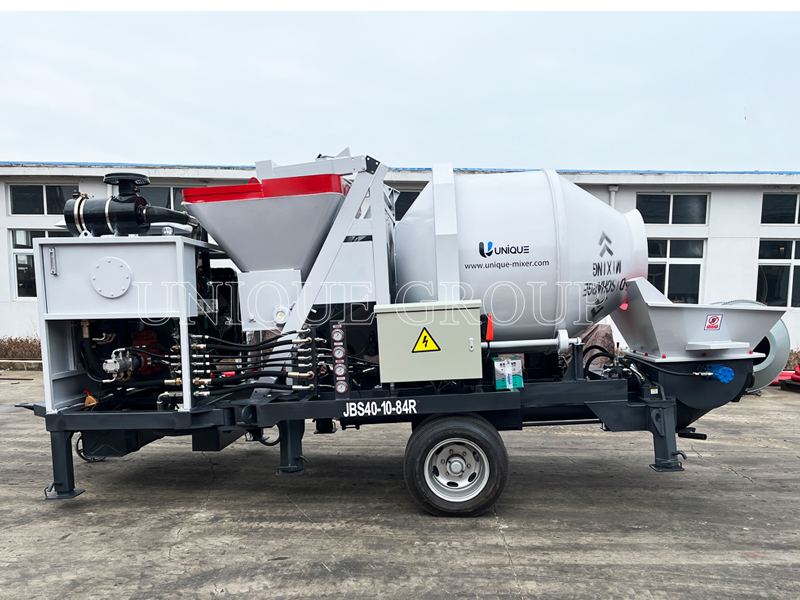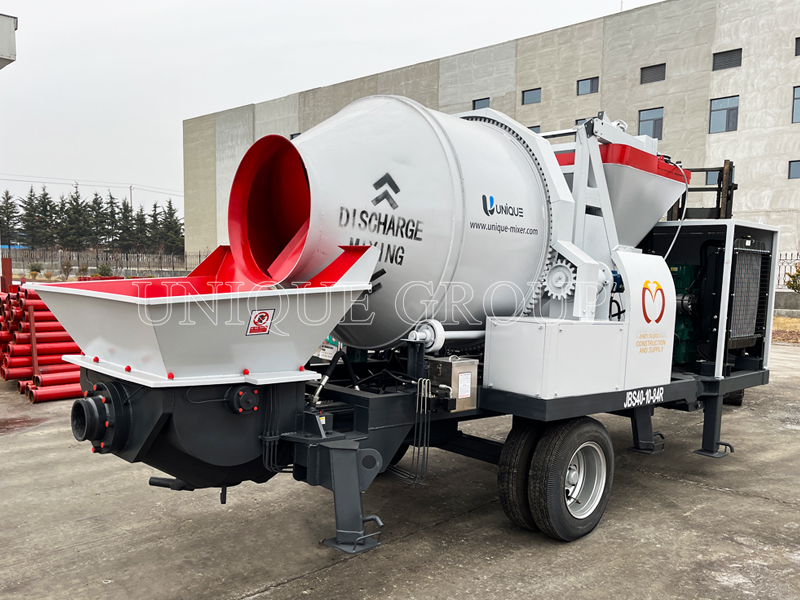How Does The Concrete Mixer with Pump Work?
2025-05-10 10:49:33The Concrete Mixer with Pump - A Revolution in Concrete Placement
The concrete mixer with pump, often referred to as a concrete mixer pump, is a revolutionary piece of construction equipment that combines the functions of a traditional concrete mixer and a concrete pump into a single, highly efficient unit. This integration eliminates the need for separate mixing and pumping processes, streamlining concrete production and delivery, ultimately saving time, labor, and costs on construction sites. Its versatility and efficiency have made it an indispensable tool for a wide range of projects, from small residential builds to large-scale infrastructure developments.
I. Core Components and Their Functions
To understand how a concrete mixer with pump operates, it’s essential to grasp the roles of its key components:
-
Mixing Drum:
- Function: This is the heart of the mixing process. It’s a large, rotating drum, typically with spiral blades or paddles inside. The rotation of the drum, driven by a powerful motor, thoroughly blends the concrete ingredients – cement, sand, aggregates (gravel or crushed stone), and water – into a homogeneous mixture.
- Design: The drum’s design is crucial for effective mixing. The shape and arrangement of the blades or paddles are engineered to ensure optimal mixing action, promoting even distribution of materials and preventing segregation.
- Capacity: Mixer drums come in various capacities, measured in cubic meters or cubic yards, to accommodate different project sizes and concrete demands.
-
Pumping Mechanism:
- Function: Once the concrete is properly mixed, the pumping mechanism transfers it from the mixing drum to the desired location, often through a system of hoses and pipes.
- Types:
- S-Valve Pumping System: This is a common type, utilizing an S-shaped valve to alternately draw concrete from the mixing drum and push it through the delivery pipeline. It’s known for its ability to handle larger aggregate sizes and its relatively simple design.
- Piston Pumping System: This system uses a piston to create pressure that pushes the concrete through the delivery system. It can achieve higher pumping pressures and is often used for high-rise buildings or long-distance pumping.
- Hydraulic System: Both S-valve and piston pumps are powered by a hydraulic system, which provides the necessary force for the pumping action.
-
Hopper:
- Function: The hopper is where the raw materials (cement, sand, aggregates) are loaded into the machine. It’s typically equipped with a grid or filter to prevent oversized materials from entering the mixing drum.
- Design: The hopper’s design facilitates easy loading of materials, often with a large opening and a feed conveyor that can be used to transport materials from a separate source.
-
Water Tank and Water Pump:
- Function: The water tank stores the water needed for the concrete mix. The water pump delivers water to the mixing drum in a controlled manner, ensuring the correct water-cement ratio for optimal concrete strength and workability.
- Control: The water flow is usually controlled by a flow meter or a similar device, allowing precise adjustment of the water content during the mixing process.
-
Control Panel:
- Function: The control panel is the operator’s interface with the machine. It houses the controls for starting and stopping the mixing and pumping operations, adjusting the speed of the mixing drum and the pumping rate, and monitoring various parameters like hydraulic pressure, engine temperature, and fuel level.
- Automation: Modern concrete mixer pumps often feature advanced control systems with automated functions, such as automatic mixing cycle timers, water dosage control, and remote operation capabilities.
-
Delivery Pipeline:
- Function: This is a system of rigid pipes and flexible hoses that carries the mixed concrete from the pump outlet to the placement point.
- Material: The pipeline is typically made of wear-resistant materials to withstand the abrasive nature of concrete.
- Length and Diameter: The length and diameter of the pipeline are determined by factors like the pumping distance, the height of the pour, and the concrete mix’s consistency.
-
Engine/Power Source:
- Function: The engine provides the power needed to drive the mixing drum, the pumping mechanism, the water pump, and other auxiliary systems.
- Types: Concrete mixer pumps can be powered by diesel engines, electric motors, or a combination of both. Diesel engines offer greater mobility and are suitable for remote sites, while electric motors are preferred for indoor applications or areas with strict emission regulations.
II. Operational Principles and Sequence of Functions
Now that we’ve explored the key components, let’s delve into the operational principles and the sequence of functions that make the concrete mixer with pump such an efficient machine:
-
Preparation and Loading:
- The machine is positioned at the desired location, ensuring a stable and level setup.
- The hopper is filled with the required amounts of cement, sand, and aggregates. The proportions of these materials are determined by the desired concrete mix design.
- The water tank is filled with clean water.
- The delivery pipeline is connected to the pump outlet and extended to the placement point.
-
Mixing Process:
- The operator starts the mixing drum using the control panel.
- As the drum rotates, the materials in the hopper are gradually fed into the drum.
- The water pump is activated, delivering water to the drum in a controlled manner.
- The rotating drum and the action of the internal blades or paddles thoroughly mix the ingredients, creating a uniform concrete mixture.
- The mixing process continues for a specific duration, usually determined by the concrete mix design and the desired consistency. This duration can be set using the control panel’s timer function.
-
Pumping Process:
- Once the concrete is adequately mixed, the operator initiates the pumping process.
- In an S-valve system, the S-valve oscillates, alternately drawing concrete from the mixing drum and pushing it into the delivery pipeline.
- In a piston pump system, the piston creates pressure that forces the concrete through the pipeline.
- The operator can adjust the pumping rate using the control panel to match the placement speed and prevent blockages.
-
Concrete Placement:
- The mixed concrete travels through the delivery pipeline to the placement point.
- At the end of the pipeline, the concrete is discharged and placed in the desired location, such as a foundation form, a wall, or a slab.
- The operator can control the flow of concrete at the discharge point using a valve or a similar device.
-
Cleaning and Maintenance:
- After the concrete placement is complete, the machine and the delivery pipeline must be thoroughly cleaned to prevent concrete buildup and blockages.
- This typically involves flushing the system with water and using specialized cleaning tools to remove any residual concrete from the mixing drum, the pump, and the pipeline.
- Regular maintenance, including lubrication of moving parts, inspection of wear parts, and engine servicing, is essential to ensure the machine’s optimal performance and longevity.
III. Efficiency and Advantages in Modern Construction
The concrete mixer with pump offers numerous advantages that contribute to its widespread use in modern construction:
-
Time Savings:
- The integrated mixing and pumping functions eliminate the need for separate processes, significantly reducing the overall time required for concrete placement.
- This faster turnaround time translates to quicker project completion and increased productivity.
-
Labor Reduction:
- By automating the mixing and pumping processes, the concrete mixer pump reduces the need for manual labor.
- Fewer workers are required for tasks like mixing, wheelbarrowing, and shoveling concrete, leading to lower labor costs.
-
Cost-Effectiveness:
- The reduced time and labor requirements result in lower overall project costs.
- The efficient use of materials, with precise water dosage control, also contributes to cost savings.
-
Improved Concrete Quality:
- The thorough mixing action of the drum ensures a homogeneous concrete mixture with consistent quality.
- The controlled water dosage prevents variations in the water-cement ratio, leading to better concrete strength and durability.
-
Versatility:
- Concrete mixer pumps can handle a wide range of concrete mixes, from low-slump to high-slump, and can be used for various applications, including foundations, walls, slabs, and even shotcreting.
- Their mobility allows them to be easily transported to different job sites and repositioned as needed.
-
Safety:
- The mechanized operation reduces the physical strain on workers, minimizing the risk of injuries associated with manual concrete handling.
- Modern machines are equipped with safety features like emergency stop buttons, safety guards, and warning alarms to ensure operator safety.
-
Environmental Benefits:
- The efficient use of materials reduces waste and minimizes the environmental impact of concrete production.
- Electrically powered models offer a cleaner alternative to diesel engines, reducing emissions on job sites.
Conclusion: The Future of Concrete Placement
The concrete mixer with pump is a testament to the construction industry’s ongoing quest for efficiency, productivity, and innovation. Its ability to integrate mixing and pumping into a single, streamlined process has revolutionized concrete placement, offering significant time and cost savings while improving the quality of the final product. As construction projects become increasingly complex and demanding, the role of the concrete mixer pump is only set to grow, solidifying its position as an indispensable tool for modern construction. With ongoing advancements in technology, we can expect even greater levels of automation, control, and performance from future generations of these versatile machines, further transforming the way we build our world.
PRODUCT TYPE LIST
NEWS
Contact Us
Address:Industrial Equipment Zone,Zhengshang Road Zhengzhou Henan
Zip: 450000 China
Fax:+86-371-63935058
E-mail:sales@unique-cons.com
TEL:+86-371-63699132








